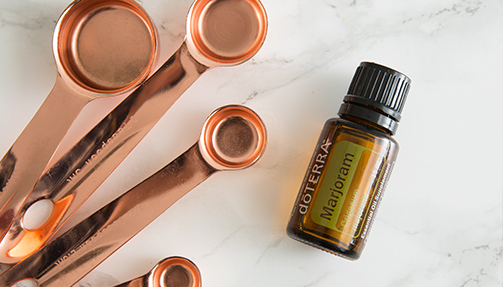Origin: a Latin derivative
meaning "Gift of the Earth."
Product Spotlight: Marjoram

Believed to be native to the eastern Mediterranean, Marjoram was used anciently in Greece. The Greeks and Romans saw marjoram as a symbol of happiness; they would make wreaths of marjoram for newlywed couples to ensure happiness and love. It is now grown in gardens all over the world today as a culinary herb. As a perennial plant, it can continue to grow year after year in warmer climates, but in colder climates where it won’t survive the freeze, it is used as an annual plant and dried for use during the winter.
Close Relatives
It is related to, and sometimes confused with, oregano. Both plants are from the mint family and the same genus of plants known as origanum. (In fact, another name for oregano is wild marjoram.) The difference between the two, however, is apparent as soon as you smell them. Open their bottles of essential oil and Oregano’s pungent scent is sharp, green, and camphoraceous, while Marjoram’s scent is more mild and sweet, with a minty and woody note.regano and Marjoram oil’s scents and benefits are linked to their differing main chemical components. Marjoram is made up of terpinen-4-ol, sabinene hydrate, and y-terpinene. Following the trend set out by its softer, sweeter scent, Marjoram is more soothing and useful for calming a fussy toddler by putting it on the boot of their feet. It can also be used for your own stressed feelings by putting it on the back of your neck.
Cautions
Possible skin sensitivity. Keep out of reach of children. If you are pregnant, nursing, or under a doctor’s care, consult your physician. Avoid contact with eyes, inner ears, and sensitive areas.





